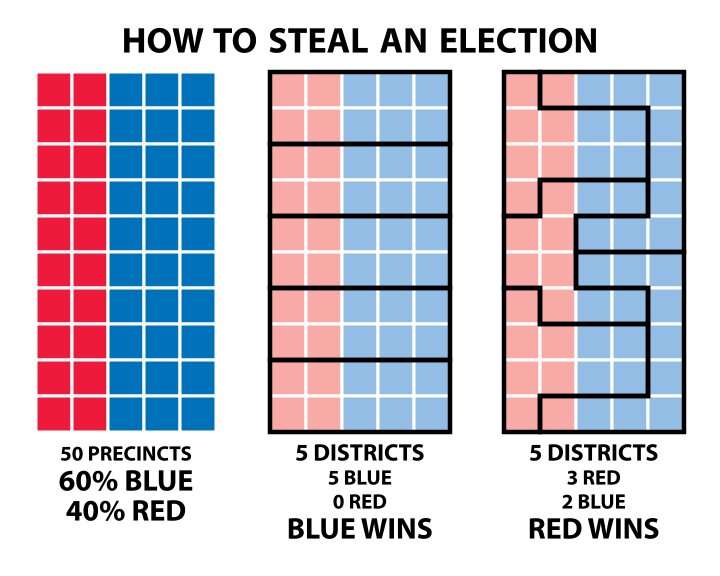Political parties use gerrymandering to counteract shifting voter preferences in key battleground states, study finds

During midterm elections this November, voters across the country will head to the polls to decide who should represent them for the next two years in the U.S. House of Representatives. But, in some states, they may have a harder time making their voices heard this year, in part, because it's the first election following a redistricting cycle. New research from UC Santa Cruz that focused on "swing states," where political parties are evenly matched, suggests that whichever party controls the redistricting process in the state legislature engineers an 11 percentage point increase in its probability of winning a U.S. House race in the next election. And these advantages often run counter to the will of voters.
Researchers attributed this effect to "gerrymandering," which is the redrawing of voting district boundaries in ways that intentionally advantage one political party over the other. The redistricting process takes place every 10 years following the U.S. Census and is intended to ensure that each district remains representative of the state's people as populations shift. But when this process is controlled by a state's legislature, the party in the majority may instead shape districts strategically to either pack opposition voters into fewer districts or ensure a slight majority of their party's voters across a greater number of districts.
Ultimately, gerrymandering is a way for political parties to minimize the electoral impact of opposition voters without actually winning a greater share of votes. And to calculate just how much impact this can have, UC Santa Cruz Associate Professor of Economics Ajay Shenoy and World Bank economist Dahyeon Jeong applied data analysis techniques from the field of economics to study elections after redistricting cycles from 1970 to 2010 in hotly contested battleground states where legislatures controlled redistricting.
The study's unique methods applied "bunching tests" to real-world data to look for non-random patterns in election results that can only arise through strategic party behavior. And the finding that gerrymandering conferred an average 11 percentage point advantage in swing states was just the tip of the iceberg. The team also took a close look at the conditions under which these advantages arose and found that, in the election before a redistricting cycle, political parties systematically won narrow majorities in the legislatures of states where they had recently lost U.S. House races. Then, in the election after redistricting, the trend of that party's losses at the federal level reversed, despite no change in their share of votes.
"The deeper question of this work was not just a matter of whether parties that control redistricting use that to their advantage, but also where and why they wind up in control," Shenoy explained. "And our findings suggest that parties seek control of redistricting in places where the electorate is turning against them, which is, in some ways, more concerning because it indicates that redistricting is being used to actively thwart the popular will."
Shenoy says parties seem to focus heavily on elections at the state level leading up to redistricting. They may strategically channel funds, delay retirements of incumbents, or prioritize particular election campaigns, all with the goal of winning a narrow majority in state legislatures where they have recently lost U.S. House seats. And if a political party succeeds in winning the majority, researchers found that they then switch from near-universal opposition to the new redistricting plan to near-universal support, demonstrating confidence that the process would work in their favor. A slightly larger share of Republicans than Democrats were willing to support a redistricting bill led by the opposition party.
The study also documented some specific gerrymandering techniques. In particular, Republican legislatures were roughly 15 percentage points more likely than Democratic legislatures to move majority-Black census tracts to new districts, especially those districts that were already overwhelmingly Black.
"That behavior might be consistent with racial gerrymandering," Shenoy said. "You have a racial group that's visibly Democratic in its voting patterns, and these results may show how those voters are being packed into a smaller number of districts, where they have less of a chance of influencing the outcome of elections."
Researchers identified another concerning trend that may warrant further research. Across most of the time period analyzed in the study, the initial advantage afforded to a party by gerrymandering would typically fade by the next election cycle, since continued shifts in voting trends ultimately outweighed redistricting advantages engineered on narrow margins. But when the team looked specifically at more recent data from the years 2001 through 2011, they found some evidence that the advantage of gerrymandering may be persisting longer.
While more data is needed, this initial finding could be a warning sign. The research team suspects that increasingly sophisticated computer simulations of voter behavior, which have emerged since the mid-1990s, may be making gerrymandering easier and more effective than ever. Overall, Shenoy hopes the study's findings may be useful to voting rights advocates and government authorities tasked with ensuring free and fair elections. The U.S. Supreme Court ruled in 2019 that federal courts could not judge cases of partisan redistricting, but legislators and state courts can still take action on these issues.
"State supreme courts might be interested in this if their state constitutions have a guarantee of equal protection or equal representation," Shenoy said. "We find fairly convincing evidence that partisan redistricting is substantially altering outcomes, especially in places where the electorate had been moving against a party, and that's quite troubling if you are a court that believes it has a mandate to prevent that kind of thing."
The research was published in The Review of Economics and Statistics.
More information: Dahyeon Jeong et al, The Targeting and Impact of Partisan Gerrymandering: Evidence from a Legislative Discontinuity, The Review of Economics and Statistics (2022). DOI: 10.1162/rest_a_01204
Journal information: Review of Economics and Statistics
Provided by University of California - Santa Cruz





















